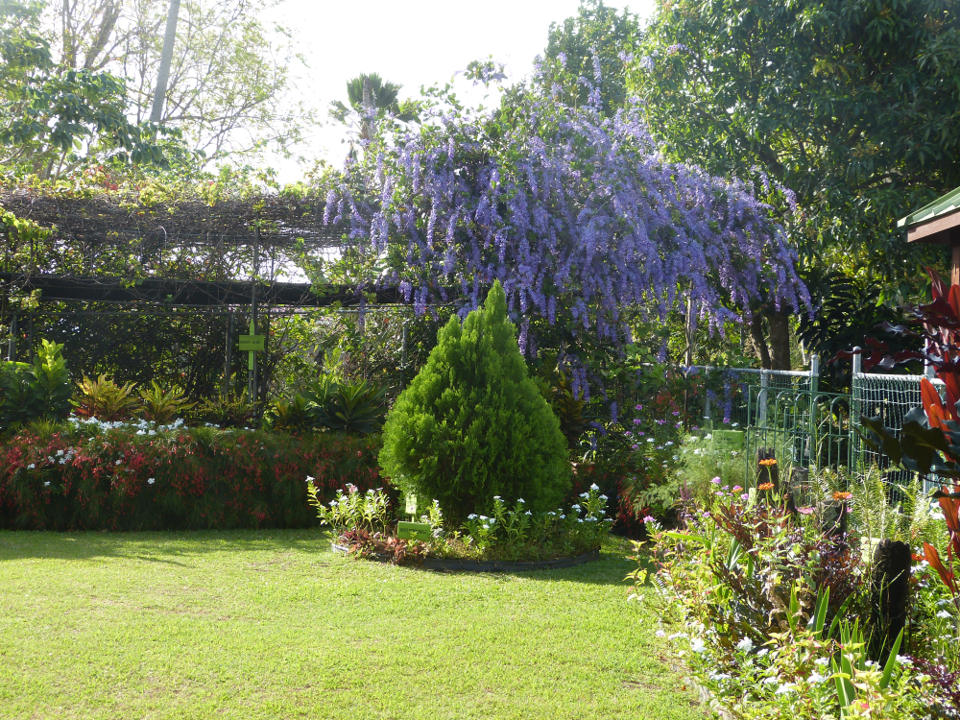
Greenwood Terrace: A Tour
* This article originally featured on the Inner Senses website – click here to read the original article *
In the sunny blue sky, Superman flew against the backdrop of a single mountain emerging majestically from the sea, only to land by a waterfall in lush tropical gardens. There he plucked two orange Heliconia from the ground – the Bird of Paradise flower – synonymous with tropical landscapes.
This scene from the film Superman II was shot on location at the Diamond Botanical Gardens, St Lucia, with cinematography typical of a 1980 release. It certainly doesn’t do the spectacular scenery any justice, but then again nor would it even if filmed today, for every facet of this tropical paradise is imbued with a vibrancy that transcends the visual. It beckons you to connect with its verdant interior and immerse yourself in the azure waters and golden sands of its coast; its sights, its sounds, its aromas, and its energy.
In this article, Inner Senses’ founder, Lisa, discusses her tour of Greenwood Terrace and the abundance of natural resources in St Lucia that sparked her love and passion for natural and organic products.
NATURAL RESOURCES IN ST LUCIA
The island of St Lucia lies in the Eastern Caribbean. Small but bountiful, it is built on volcanic rock, providing rich soil with an abundance of nutrients in which vegetation thrives. It spans 238 square miles, over 70% of which is forested, and with 25.5% of this being classified as primary forest, the most biodiverse and carbon-dense form of forest on Earth. It was this rainforest that captured my heart some 15 years ago when I worked in the region and I return when the chance allows.
On one such occasion, in 2019, I had the pleasure of interviewing several farmers with smallholdings that focused on organic produce for export (namely bananas and cocoa beans from which the fat it extracted and sold as butter), a bush-doctor who recounted the medicinal plant-wisdom passed down through many generations, and the staff of Greenwood Terrace Medicinal Gardens.
A HAVEN IN ST LUCIA – GREENWOOD TERRACE
Located in the district of Marisule to the North of the island, Greenwood Terrace is approached via a steep road named Glasgow Hill, a nod to St Lucia’s colonial past. The elaborate sloping grounds are as lush as you would imagine, brimming with tropical fruit trees, flowers, and plants.
Here you can discover indigenous scents and flavours used historically by the island’s original inhabitants, the Antillean Arawak, in medicine and cuisine.
I was taken on a private tour by staff member Showane Williams, whose job entailed tending the gardens and who shared his excellent knowledge of everything that grew there, reminding me of the ample natural resources in St Lucia, and their medicinal applications. I made my first rookie error when I remarked on the “gorgeous banana trees”, which of course are not trees, but plants, evidenced by their absence of a hard bark and their high water content of over 80%. Towering plantain and banana plants look almost identical, the main discernible difference being a purple marking on the petiole of the plantain plant, and the rule for both is that when green they are a vegetable, and when yellow they are a fruit. Ripe plantains are often crushed into a flour and purported to have laxative properties, and iron-rich unripe bananas form part of St Lucia’s national dish, green bananas and codfish.
I was particularly looking forward to learning more about the Annona muricata (Soursop) tree, a broadleaf, flowering, evergreen that bears a delicious fruit also referred to as Graviola, Guanabana and Spiky Fruit. The leaves are widely used to make a specific kind of tea with soporific effects, consumed by adults and given to babies and children to bring calm in the evening.
The cold-pressed seeds yield an oil which is recently gaining popularity for its excellent skincare properties, most notably it’s antibacterial, antioxidant, and anti-inflammatory benefits, however its ability to slow the proliferation of cancer cells and reduce the size of tumours is undoubtedly of greatest interest. One of Soursop’s principal constituents, Annonacin, seems to be largely responsible for this action, and while it’s too early to draw solid conclusions, numerous in-vivo studies are adding to a growing evidence-base that appear to validate its promise as an anticancer agent. This is simply one example of a natural resource in St Lucia that could be revolutionising various treatments.
A JOURNEY OF NATURAL DISCOVERY
Passing a patch of pineapples – locally known as Zanana – I learned that it was easy to grow, requiring plenty of sunlight and just a little water since it retains water like a cactus. Pineapple is a great source of both AHA’s and BHA’s (most notably Bromelain), both used widely within natural skincare products for their gentle exfoliating and rejuvenating properties.
Towering mango trees stood laden with fruit, deliciously sweet and offering wide skincare and medicinal applications. St Lucia boasts no less than forty-eight different species of mango, with both the leaves and bark being commonly used as remedies for yellow jaundice, fever, malaria, diabetes, glaucoma, and hypertension. Leaves are used to prepare a tea by boiling whilst uncovered to allow the contained toxins to be released.
From the coffee family Rubiaceae, the Morinda citrifolia is a fruit-bearing tree from which we picked a Noni fruit. Known by many names including Great Morinda, cheese fruit and the unappealing vomit fruit, the Noni has a pungent vomit-like scent. Regarded as famine-food in come cultures, and yet a staple food of others, it is widely used within the cosmetics industry and locally it is used in the treatment of hypertension and kidney stones.
Aromatic herbs, trees and plants were abundant; coriander, thyme, sweet marjoram, and the beautiful West Indian Bay tree (pimenta racemose). Leaves of the West Indian bay, also known as the Spice Tree, are more aromatic than bay leaves found in other continents, with complex notes of cinnamon, allspice, cloves, vanilla, and nutmeg, making them perfect for culinary use. Indeed, they are consumed extensively in the Caribbean region in everything from stews and soups to porridge. Steam distillation of the fruit and leaves yields an essential oil with wide medicinal and cosmetic applications. It is a good antibacterial and astringent, and an excellent analgesic, used locally (and globally) as a remedy for joint aches and general pains. The essential oil is also used to make the cologne Bay Rum, which is not ingestible, but used topically as a warming panacea for 101 ailments.
And finally, the Panadol Plant (Plectranthus Caninus); a little-documented member of the mint family that is a commonly used herbal medicine in St. Lucia, most notably for pain relief where it is boiled and drunk as a tea. Thought to take its common name from its analgesic properties, it was used traditionally in Africa as treatment for gum and skin disease and has a diuretic action. When rubbed, the leaves emit a sweet herbaceous aroma that is somehow so familiar, very much like oregano, but not quite the same, because no two things in Nature ever are.
AROMATHERAPY WITH INNER SENSES
From their earliest training, every aromatherapist will be accustomed to working with plants from the Lamiaceae family such as lavender, rosemary, mint, marjoram, and thyme, since they yield some of the most frequently used essential oils.
Over decades of use, I’ve become so intimately familiar with certain oils that, whilst continuing to be in awe of their extensive benefits, they become somewhat predictable and can lack the intrigue and excitement of working with a novel ingredient. And it is at that moment where you deign to think ‘I know’, that Mother Nature presents you with a brand new discovery called the Panadol Plant, a reminder that despite her certainty she is forever changing, and that she is so very complex, in spite of her beautiful simplicity.
Written by Lisa Basso
©️ Lisa Basso, 2020
Acknowledgements: I would like to thank all the staff at Greenwood Terrace for warmly welcoming my 7 year-old daughter and I for a guided tour and to experience their delightful farm-to-table cuisine prepared for me in a cookery lesson on site. Your freshly prepared, icy golden-apple juice was the most delicious I’ve ever tasted! Thank you for your hospitality.






